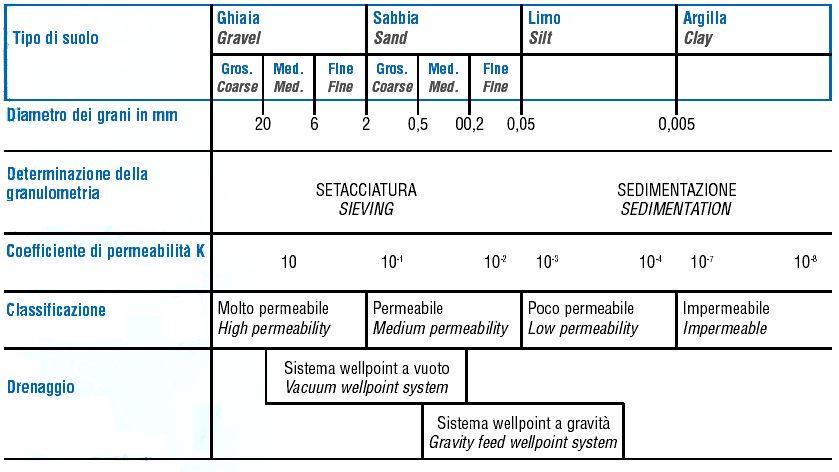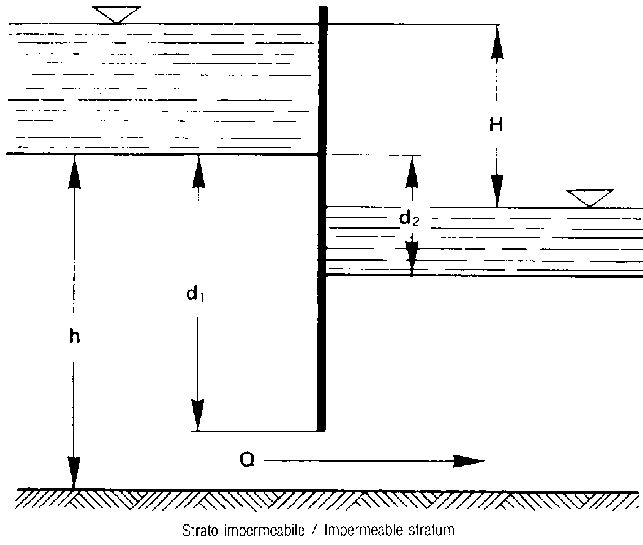
Limits of the wellpoint system
The wellpoint system represents the cheapest and simplest solution for excavating in the presence of water, but it must be reminded that just a few variations in the stratigraphic and hydrogeological parameters of the land can determine the exclusion of this system or the integration with other methods. The theoretical drainage limits with the wellpoint system are shown in the following table.

The main practical limitations to drainage with the wellpoint system are:
1) presence of gravel soils with large granulometry and high permeability;
2) presence of rocky soils with permeability due to cracking;
3) limited spaces that require mechanical containment of the excavation walls for safety reasons;
4) excavation depths greater than 10-14 meters;
5) particular hydrogeological and hydrological conditions that result in insufficient plant yield.
1. Excavation in gravelly soils
When the size of the gravel exceeds 5-10 cm in diameter, the wellpoint points cannot be used due to the resistance opposed by the gravel to the insertion. Although tests have been carried out with vibrators, compressors and mechanical pile drivers, a standard driving methodology that can be used in more types of gravel has not been reached. Another limit to the use of the wellpoint system is represented by the fact that in nature gravel soils, in most cases, have a finer matrix, generally silty or clayey. In the presence of such matrices, the normal wellpoint filters, consisting of a double steel reps, tend to clog as soon as pumping is started. In washed-out gravels (without a fine matrix and therefore without a decrease in permeability), the limit capacity of the wellpoint system is insufficient compared to the potential of the groundwater which is subject to strong power due to high underpressures. The number of wellpoint filters to be used would become practically unlimited with all the consequent negative implications. In particular it can be summarized that
The wellpoint system cannot be used:
– when the size of the gravel exceeds 5-10 cm in diameter;
– when the gravel matrix is made up of silts or clays;
– when the gravels are washed away and the groundwater is subjected to strong feeding.
2. Excavation in rocky terrain
It is known that the wellpoint system to recall water exploits the pressure difference that is created between the filter and the atmospheric pressure weighing on the groundwater surface. In practice, the indispensable condition for its effectiveness is that the soils have a continuity of voids (permeability by porosity) and therefore there is an aquifer flow through them or the possibility that it exists. Rocky soils may not have this requirement, as they often consist of waterproof formations cracked by fracturing or dissolution, and the flow of water can circulate through paths that cannot be identified. It is evident in these cases the impossibility of creating an area of influence; any interception would be purely random and there would be no guarantee of success in using the wellpoint system.
3. Excavation in confined spaces
The lowering of the groundwater with the wellpoint system causes stabilization of the excavation walls, but this can only happen when the slopes have an inclination, a function of the characteristic friction angle of the ground, such as to positively satisfy the stability verification. When, due to lack of space or for safety reasons, it is not possible to respect the necessary inclination of the embankments, it is necessary to intervene with complementary methods that have the function of mechanical support of the excavation. The most used methods for this are concrete bulkheads and sheet piling. Remember that these systems alone cannot solve the problems related to the presence of the aquifer (if they do not reach depths such as to affect some impermeable layer), as they counteract the lateral hydraulic thrusts but do not prevent the backflow from the bottom. In these cases, the calculation of the ebb flow becomes very important and one of the methods used is the one that refers to Muskat’s theory.
Q = to KH
The explanation of the symbols is shown in the following diagrams.
4. Deep excavations
For the execution of excavations in the presence of an aquifer at depths greater than 10-14 m, the wellpoint type drainage system is generally not used, even if the excavation soils are theoretically suitable for its use. Some of the reasons are as follows:
– the earthmoving necessary for the laying of the various stages of wellpoint systems, with the need to respect very wide excavation slopes, would assume such proportions as to often become unacceptable;
– the consumption and maintenance of the various stages of wellpoint systems determine, especially for large excavations, logistical, operational and economic conditions of the construction site so heavy as to become impossible to propose;
– the risks connected to the safety of the excavations would become too high as one proceeds towards the bottom.
In fact, it is not advisable, if not following very in-depth technical investigations, to rely on the efficiency of very deep wellpoints stages since the probability of problems occurring increases proportionally with the depth.



